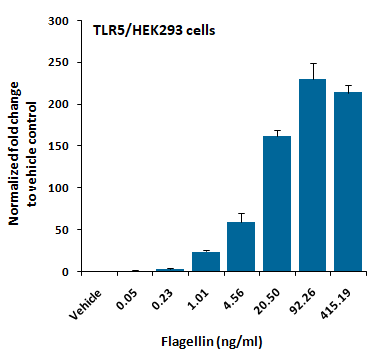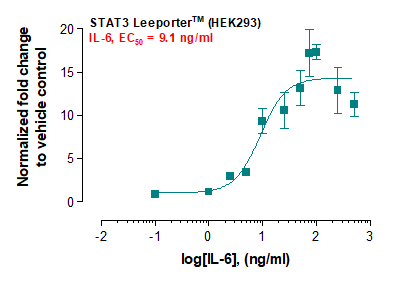Recombinant Mouse Lymphotoxin beta Receptor/LTBR/TNFRSF3/TNFRrp (C-Fc)(Discontinued)
Shipping Info:
For estimated delivery dates, please contact us at [email protected]
| Amount : | 50 µg |
| Content : | Lyophilized from a 0.2 µm filtered solution of PBS,pH7.4. |
| Storage condition : | Lyophilized protein should be stored at -20°C, though stable at room temperature for 3 weeks. Reconstituted protein solution can be stored at 4-7°C for 2-7 days. Aliquots of reconstituted samples are stable at -20°C for 3 months. |
| AA sequence : | SQPQLVPPYRIENQTCWDQDKEYYEPMHDVCCSRCPPGEFVFAVCSRSQDTVCKTCPHNSYNEHWNHLSTCQLCRPCDIVLGFEEVAPCTSDRKAECRCQPGMSCVYLDNECVHCEEERLVLCQPGTEAEVTDEIMDTDVNCVPCKPGHFQNTSSPRARCQPHTRCEIQGLVEAAPGTSYSDTICKNPPEPVDDIEGRMDEPKSCDKTHTCPPCPAPELLGGPSVFLFPPKPKDTLMISRTPEVTCVVVDVSHEDPEVKFNWYVDGVEVHNAKTKPREEQYNSTYRVVSVLTVLHQDWLNGKEYKCKVSNKALPAPIEKTISKAKGQPREPQVYTLPPSREEMTKNQVSLTCLVKGFYPSDIAVEWESNGQPENNYKTTPPVLDSDGSFFLYSKLTVDKSRWQQGNVFSCSVMHEALHNHYTQKSLSLSPGK |
Source: Human Cells.
MW :48.7kD.
Recombinant Mouse Lymphotoxin beta Receptor is produced by our Mammalian expression system and the target gene encoding Ser28-Pro218 is expressed with a Fc tag at the C-terminus. It is a single-pass type I membrane protein and contains 4 TNFR-Cys repeats. The protein is a member of the tumor necrosis factor (TNF) family of receptors. It is expressed on the surface of most cell types, including cells of epithelial and myeloid lineages, but not on T and B lymphocytes. The protein is the receptor for the heterotrimeric lymphotoxin containing LTA and LTB, and for TNFS14/LIGHT. It promotes apoptosis via TRAF3 and TRAF5 and may play a role in the development of lymphoid organs. The encoded protein and its ligand play a role in the development and organization of lymphoid tissue and transformed cells. Activation of the encoded protein can trigger apoptosis. Not only does the TNFRSF3 help trigger apoptosis, it can lead to the release of the cytokine interleukin 8. Overexpression of TNFRSF3 in Human Cells cells increases IL-8 promoter activity and leads to IL-8 release. TNFRSF3 is also essential for development and organization of the secondary lymphoid organs and chemokine release.
MW :48.7kD.
Recombinant Mouse Lymphotoxin beta Receptor is produced by our Mammalian expression system and the target gene encoding Ser28-Pro218 is expressed with a Fc tag at the C-terminus. It is a single-pass type I membrane protein and contains 4 TNFR-Cys repeats. The protein is a member of the tumor necrosis factor (TNF) family of receptors. It is expressed on the surface of most cell types, including cells of epithelial and myeloid lineages, but not on T and B lymphocytes. The protein is the receptor for the heterotrimeric lymphotoxin containing LTA and LTB, and for TNFS14/LIGHT. It promotes apoptosis via TRAF3 and TRAF5 and may play a role in the development of lymphoid organs. The encoded protein and its ligand play a role in the development and organization of lymphoid tissue and transformed cells. Activation of the encoded protein can trigger apoptosis. Not only does the TNFRSF3 help trigger apoptosis, it can lead to the release of the cytokine interleukin 8. Overexpression of TNFRSF3 in Human Cells cells increases IL-8 promoter activity and leads to IL-8 release. TNFRSF3 is also essential for development and organization of the secondary lymphoid organs and chemokine release.
Always centrifuge tubes before opening. Do not mix by vortex or pipetting. It is not recommended to reconstitute to a concentration less than 100 µg/ml. Dissolve the lyophilized protein in ddH2O. Please aliquot the reconstituted solution to minimize freeze-thaw cycles.
Endotoxin : Less than 0.1 ng/µg (1 IEU/µg) as determined by LAL test.
For Research Use Only. Not for use in diagnostic/therapeutics procedures.
| Subcellular location: | Membrane |
| BioGrid: | 201222. 5 interactions. |
|
There are currently no product reviews
|













.png)












